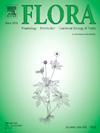Interplay of ant defense and leaf functional traits determine herbivory and fluctuating asymmetry during ontogeny of a myrmecophytic tropical plant
IF 1.8
4区 生物学
Q3 ECOLOGY
引用次数: 0
Abstract
Tree ontogeny leads to changes in life history traits due to reproduction costs. Understanding the ecological mechanisms influencing biotic interactions is crucial, considering the relationship between functional traits in the leaf economic spectrum with herbivory along plant ontogeny. We investigated ontogenetic variation on leaf functional traits of ant-plant mutualistic interactions in the myrmecophyte Cordia alliodora and their consequences for leaf herbivory and fluctuating asymmetry. We sampled leaves of 25 juvenile and 25 mature trees to determine eight leaf functional traits, leaf herbivory and fluctuating asymmetry. We also determined domatia and ant number to evaluate ant-defense. All leaf functional traits differed from juvenile to mature trees, supporting change from an acquisitive to a conservative strategy in resource use along the continuum of leaf economic spectrum. Juvenile trees hosted more worker ants, while mature trees had higher herbivory and fluctuating asymmetry. Leaf herbivory was negatively influenced by ant defense, reinforcing the importance of ant-plant interactions, as well as positively related to defensive traits (leaf density and dry matter content) and fluctuating asymmetry, but negatively with the specific leaf area. Conservative traits were not linked to leaf herbivory. Instead, C. alliodora allocates higher resources to ant defense in juvenile trees. Fluctuating asymmetry was positively associated with leaf herbivory in juvenile and mature trees, remarking that fluctuating asymmetry is a valuable biomarker of plant-stressors. Predictions related to leaf herbivory and fluctuating asymmetry should consider complex biotic interactions, including myrmecophily, and life history trade-offs arising from defensive investment.
蚂蚁防御和叶片功能性状的相互作用决定了一种桃生热带植物在个体发育过程中的食草性和波动性不对称性
由于繁殖成本的原因,树木个体发生导致生活史性状的变化。考虑到叶片经济谱上的功能性状与草食和植物个体发育之间的关系,了解影响生物相互作用的生态机制至关重要。研究了金兜草抗植物互作过程中叶片功能性状的个体发生变异及其对叶片食草性和波动不对称性的影响。以25棵幼树和25棵成熟树为样本,测定了8个叶片功能性状、叶片食草性和波动不对称性。测定了蚁群数量和蚁群数量来评价其抗防御能力。幼树和成熟树的所有叶片功能性状都存在差异,支持了资源利用在叶片经济谱连续体上由获取策略向保守策略的转变。幼树寄主较多工蚁,而成熟树寄主较多草食和波动不对称。叶片食草性受蚂蚁防御的负向影响,强化了蚂蚁与植物相互作用的重要性,与防御性状(叶密度、干物质含量)和波动不对称性正相关,与比叶面积负相关。保守性状与叶片食草性无关。相反,C. alliodora将更多的资源分配给幼树的蚂蚁防御。波动不对称与幼树和成熟树的叶片食草性呈正相关,表明波动不对称是植物胁迫源的一个有价值的生物标志物。与叶片食草性和波动不对称性相关的预测应考虑复杂的生物相互作用,包括嗜蜜性,以及防御投资引起的生活史权衡。
本文章由计算机程序翻译,如有差异,请以英文原文为准。
求助全文
约1分钟内获得全文
求助全文
来源期刊

Flora
生物-植物科学
CiteScore
3.30
自引率
10.50%
发文量
130
审稿时长
54 days
期刊介绍:
FLORA publishes original contributions and review articles on plant structure (morphology and anatomy), plant distribution (incl. phylogeography) and plant functional ecology (ecophysiology, population ecology and population genetics, organismic interactions, community ecology, ecosystem ecology). Manuscripts (both original and review articles) on a single topic can be compiled in Special Issues, for which suggestions are welcome.
FLORA, the scientific botanical journal with the longest uninterrupted publication sequence (since 1818), considers manuscripts in the above areas which appeal a broad scientific and international readership. Manuscripts focused on floristics and vegetation science will only be considered if they exceed the pure descriptive approach and have relevance for interpreting plant morphology, distribution or ecology. Manuscripts whose content is restricted to purely systematic and nomenclature matters, to geobotanical aspects of only local interest, to pure applications in agri-, horti- or silviculture and pharmacology, and experimental studies dealing exclusively with investigations at the cellular and subcellular level will not be accepted. Manuscripts dealing with comparative and evolutionary aspects of morphology, anatomy and development are welcome.
 求助内容:
求助内容: 应助结果提醒方式:
应助结果提醒方式:


